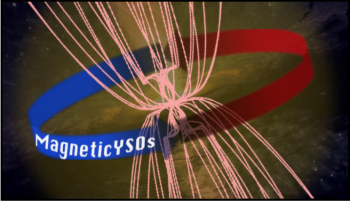Title of ERC projec: Interpreting Dust Polarization Maps to Characterize the Role of the Magnetic Field in Star Formation Processes
PI: Anaelle Maury
Rotation and the redistribution of angular momentum play a critical role in the formation and evolution of astrophysical objects, including the fundamental bricks of astrophysical structures: stars. Stars like our Sun form when rotating dense cores, in the interstellar medium, collapse until they eventually reach temperatures at which nuclear fusion begins; while planets, including the Earth, form in the rotationally supported disks around these same young stars.
One of the major challenges of modern astrophysics is the “angular momentum problem": observations show that the specific angular momentum of a typical star-forming cloud is much larger than the maximum allowed for a single star, even when rotating at break-up speed (Bodenheimer, 1995). Therefore, a star-forming cloud needs to reduce its specific angular momentum by 5 to 10 orders of magnitude to form a typical star such as our Sun. It is also crucial to solve the angular momentum problem because of its relation to other long-standing problems in astronomy such as the formation of stellar binaries and the initial mass function of newly formed stars.
Magnetic fields are one of the key ways of transporting momentum in astrophysical structures: understanding how angular momentum is transported to allow star formation requires characterizing the role of magnetic fields in shaping the dynamics of star-forming structures. The MagneticYSOs project aims at characterizing the role of magnetic field in the earliest stage of star formation, the so-called protostellar phase.
The ongoing major improvements of instrumental (polarization observing techniques at the SMA, and the development of polarization capabilities on the ALMA and NOEMA interferometers providing sensitive observations of magnetic fields with a great level of detail) and computational facilities (simulations of protostellar formation including resistive MHD, radiative transfer and chemical networks allow detailed modeling at all the relevant scales) provide us, for the first time, with the opportunity to confront observational information to magnetized models predictions. Through an ambitious multi-faceted program of dedicated observations of magnetic fields (polarized dust emission maps) and gas kinematics (molecular lines emission maps) in the youngest star-forming cores, and their comparison to synthetic observations of MHD simulations of protostellar formation, we aim to transform our understanding of:
1) The long-standing problem of angular momentum in star formation
2) The origin of the stellar initial mass function
3) The formation of multiple stellar systems and circumstellar disks around young stellar objects (YSOs)
Not only this project will enable a significant advance in our understanding of low-mass star formation, answering yet unexplored questions with innovative methods, but it will also allow to spread the expertise in interpreting high-angular resolution (sub-)mm polarization data, that only a handful of astronomers in the EC community know about so far.




